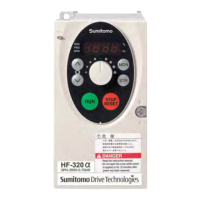
Do you have a question about the LCI HF-320 a Series and is the answer not in the manual?
| Enclosure Rating | IP20 |
|---|---|
| Efficiency | ≥90% |
| Protection Features | Overload, Over Temperature, Short Circuit |
| Ambient Humidity | 5% to 95% RH, non-condensing |
| Cooling Method | Forced Air Cooling |
Example showing how to interpret inverter model names and codes.
Highlights compact design, easy maintenance, reduced noise, high performance, and optimal acceleration.
Comprehensive tables detailing electrical, environmental, and operational specs.
Provides dimensional data including width, height, depth, and mounting details.
Covers basic operations, noise-proofing, and the use of input/output terminals.
Details monitor menus, setting ease, protective functions, dynamic operations, and communication.
Guidance on selecting capacity, starting behavior, and harmonic current impact.
Methods for reducing harmonic interference, such as connecting reactors.
Identifies and explains the function of each button, lamp, and display on the inverter panel.
Step-by-step instructions for starting, stopping, and frequency adjustment.
Detailed tables for 3-phase 200V, 400V, and 1-phase 200V models.
Details on control functions, operation specs, protective features, and environments.
Lists potential problems, error codes, and their possible causes for inverter protection.
Explains the purpose and electrical specifications of main and control circuit terminals.
Illustrates the wiring for negative logic common = COM configurations.
Illustrates the wiring for positive logic common = P24 configurations.
Shows connection examples for current signal input and multispeed operation.
Demonstrates wiring for motor with brake and positioning control applications.
Introduces parameter sections: usage, basic, monitor, LED displays, and terminal functions.
Covers parameters for frequency control, torque boost, and acceleration/deceleration timing.
Lists parameters for protection, panel operation, communication, and default settings.
Maps function numbers to specific input and output terminal roles.
Provides detailed drawings and dimensions for various inverter models.
Lists standard accessories, their ratings, and applicable wiring guidelines.
Cautions and advice on selecting peripheral equipment like contactors and breakers.
Details optional accessories like the frequency setting unit and remote operator.
Describes peripheral devices like speed meters and AC ammeters with their specifications.
Explains the use and provides specifications for DC and AC reactors.
Details the selection and connection of noise filters for various classes.
Provides methods to reduce noise, including zero-phase reactors and filters.
General advice for users, including noise reduction and continuous torque characteristics.
Important safety, installation, and operation precautions for inverter use.
Definitions of important terms like dVector control, V/F control, and stall prevention.
Details the warranty period, conditions, and exclusions for the inverter.